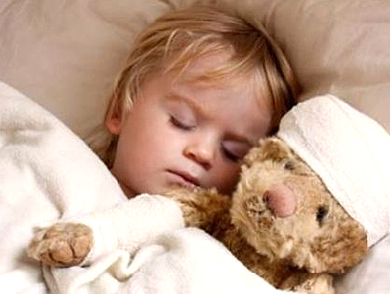Night Terrors


Image source
How many parents have woken during the night to the cries of their children? For most it is a rare event and is easily fixed with reassurance and cuddles. For some though this event can be traumatic, for them and their children, as the cries in the night signify more than normal nightmares. These children suffer from Night Terrors.
According to the Mayo Clinic Night Terrors, also known as Sleep Terrors, “are episodes of fear, flailing and screaming while asleep and are often paired with sleepwalking.” They occur in the first hour or two after the child has gone to sleep. Approximately 5 in every 100 children in Australia will suffer from Sleep Terrors and the most common ages affected are 3 – 7 but they may last until adolescence. Although they are extremely traumatic for the child and the parent they are not believed to cause any long-term harm to the child and eventually they will grow out of them.
So how to determine if your child is suffering from night Terrors. The Royal Children’s Hospital of Melbourne lists the following signs and symptoms:
• A Night Terror can begin with a piercing scream from your child, in their words “a blood curdling scream”, and your child looks very scared.
• Your child may either remain in bed, thrashing about, or may run around the room as if trying to escape from something.
• Their heart and breathing rate is accelerated.
• They are sweaty and have a glassy stare.
• For the parent the most difficult aspect is that you are unable to comfort your child or wake them from this distressing event.
• The episode can last anywhere from 5 – 20 minutes and there can be more than 1 episode in an evening.
• And amazingly they will have no memory of the Night Terror in the morning.
These symptoms differ from a nightmare where the dream usually happens in the second half of the night, you can wake your child fully from the dream, the child remembers what they were dreaming of, they can be settled by their caregiver and they will remember what happened in the morning.
So what causes Night Terrors? Unfortunately that is unknown but it has been proposed that the following are contributing factors. Firstly, if there is a familial history of Night Terrors then your child is more likely to experience them. So ask your partner and your parents if either you or they suffered from Night Terrors as a child. Secondly, stress, emotional concerns or illness appears to impact on Night Terrors. A worried or unwell child is more susceptible to a Night Terror. And finally poor sleep patterns resulting in a tired child can lead to Night Terrors.
So how do you treat Night Terrors?
As mentioned previously, there are no harmful long-term effects brought about by Night Terrors. Albeit traumatic, they can be a normal component of development in a child. Therefore there is no medical intervention required in most instances. However, it is advisable to do the following to help your child manage these events.
• Don’t make a big deal about them with your child. By focusing on them it is believed that this can contribute to their stress levels and may lead to your child becoming anxious about going to bed and to sleep. Reassure them that they are normal, many children have them and that they are going to grow out of them.
• Due to the physical aspect of a Night Terror it is recommended to safe proof their room and your house. For example move their side table away from the bed so that they will not hit their arms or head on it if they are thrashing about. Put toys away before bed to limit items for them to trip over if they are moving about the room during a Night Terror. As mentioned previously, Night Terrors can be linked with sleepwalking so lock windows and doors so that they are contained within the house.
• Keep good sleep routines. This is extremely important, as the Night Terrors themselves will deplete the amount and quality of sleep that your child will get each night and a lack of good sleep can result in Night Terrors. So it is important to make sure that they are getting plenty of good quality rest. Form good routines at bedtime and try to strictly adhere to them.
• If stress or emotional issues are contributing to their Night Terrors try to identify what they are with your child and then seek appropriate actions to remove or limit them. For example some children will have an increase in their episodes of Night Terrors at the start of the school year. Taking steps to make the transition to school more enjoyable for your child can reduce their occurrence. Ask the school for help as they often have wonderful ideas to make this a happy and less stressful time.
• Seek medical advice if your child is falling asleep during the day from extreme fatigue, if they are particularly violent within a Night Terror or the episodes are becoming very frequent.
Remember that Night Terrors are a normal occurrence in a healthy child, have no long-term harmful effects and that they will grow out of them. If your child is suffering from them have patience, give reassurance and lots and lots of cuddles.
More information can be found at:
http://www.rch.org.au/kidsinfo/fact_sheets/Night_Terrors_nighttime_wakings/
http://www.mayoclinic.com/health/night-terrors/DS01016
http://www.nlm.nih.gov/medlineplus/ency/article/000809.htm
Dr Lorraine Scarr is a chiropractor with more than 10 years experience. She is the owner of, and sole practitioner at, The Chiropractic Works Dulwich. Her passion is to provide effective and holistic care to all family members but with particular focus on Obstetric and Pediatric care, including Birthing Skills Classes which you can find more information at http://www.chiropracticworks.com.au/pages/classes.php
She is married to David and the proud mother to their beautiful daughter Elysia.
For more information please visit http://www.chiropracticworks.com.au
Facebook: http://www.facebook.com/pages/Chiropractic-Works/183310241699400










